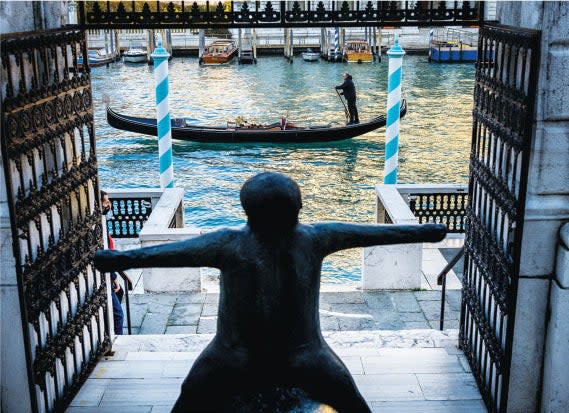Roubaix in Venice
- Oops!Something went wrong.Please try again later.
This article originally appeared on Peloton Mag
Venice is many things to those who come to this timeless city in the upper reaches of the Adriatic Sea. Some come to hang out in the Piazza San Marco. Others long for a gondola ride. Personally, I just like to amble through the backstreets of Cannaregio behind the old Jewish ghetto or up along the Fondamente Nove esplanade that looks out over the great lagoon toward the islands of Murano and Burano. But no visit is ever complete for me without visiting the jewel that is the Peggy Guggenheim Collection.
Sure, Venice is known for its many masterpieces from the Italian Renaissance. But as a student of modern art, I am always seeking original collections of 20th century art in my travels. And Peggy's collection is simply sublime. Her family's collection in New York is of course world-renowned. But Peggy always felt more at home in Venice, and thanks to her exquisite taste and uncompromising commitment to the modern movement, she built a formidable collection.
Few people would consider Venice to be a cycling mecca. But it's here in the Guggenheim Collection where I can make a cycling pilgrimage all my own. For it is here, in what used to be Peggy's dining room, where French artist Jean Metzinger's “Au Velodrome” is prominently displayed. Born in Nantes in 1883, Metzinger floated through different modern movements like Pointalism and Fauvism so typical of the French fin-desiecle period. But with the advent of Cubism, Metzinger found his calling. And while Cubism was distinctly linked to France, Metzinger's own handling of the genre also crossed the border into Italy and its parallel Futurist movement.
“Au Velodrome” is the perfect example. Formally, the work is Cubist. But its subject matter, that of a bicycle racer, is closer to Futurism, in which speed and motion were always central. For the record, the work recounts the 1912 edition of Paris- Roubaix and the final lap around the velodrome of eventual winner Charles Crupelandt. But in typical Cubist abstraction, Crupelandt is far from recognizable. Instead, his body is transformed into a mass of geometric cylinders, that somehow come together to convey a cyclist in full tuck.
The sense of movement is central, and if the viewer is a cyclist, it is clear from the position that the figure is sprinting while seated. Meanwhile, Crupelandt's face is rendered only by minimalist lines that call to mind the African masks so central to Cubist figurism. In contrast, a banner on the side of the track clearly states “Paris-Roubaix” and another (“Pneus”) refers to a tire advertisement that would likely have been found on the edge of the velodrome. Such literal references, however, were very much part of Cubist vocabulary; and the movement's leaders, including Georges Braque and Pablo Picasso, often included newspaper cutouts from French dailies such as Le Figaro.

Painted only a few years before the outbreak of World War I, Metzinger's “Au Velodrome” captures the sport of cycling in its first golden era, when cycling was championed as a chic, modern form of transportation, well before the automobile dominated city streets.
As a cyclist and lover of modern art, Metzinger's work speaks to me on many levels. I love the Roubaix velodrome and its timeless realism. Today, the stadium is falling into disrepair and the track is rough; and though this is not the same track that Metzinger painted, it hosts my absolute favorite bike race year in and year out, much like the original track did in 1912.
Metzinger did not display his velodrome work for several years, and he eventually sold it to American collector, John Quinn, while on exhibit in New York. It was only acquired in 1945 by Guggenheim, who promptly made it a central part of her own collection. Today, it is the opening piece in the collection, as the viewer sees it entering Guggenheim's dining room, the first room in the museum tour.
There are of course countless other masterpieces in Guggenheim's collection. And brilliant works by 20th century masters Picasso, Jackson Pollock, Paul Klee and Wassily Kandinsky reflect her commitment to the modern movement that make her one of the great tastemakers of her time. And the museum, perched on the Grand Canal, is itself a work of art.
Even today, it's clear that Peggy Guggenheim made her mark in her adopted city as graffiti artists celebrate her in paintings along the narrow passageways that make up this magical city. She must have been some lady, and she clearly had an imposing presence. It would have been amazing to meet her just once. I would love to have known what captivated her so with Metzinger, who, compared to many of the giants of modern art that she championed, was a relatively modest player. But she clearly championed his work--and I am grateful she did. As a lover of cycling, art and the Floating City, it offers me the perfect pilgrimage.
Hmm, let's see, what's the closest town to Venice in this year's Giro d'Italia? Well, it's Treviso, at the end of stage 18 on May 26, which is just down the road....
For exclusive access to all of our fitness, gear, adventure, and travel stories, plus discounts on trips, events, and gear, sign up for Outside+ today.

